Business Law and Ethics Report: Tort of Negligence Analysis
VerifiedAdded on 2023/01/11
|10
|3691
|48
Report
AI Summary
This report delves into the realm of business law and ethics, presenting two projects. The first project applies the Tort of Negligence to a case involving a bank (Extortionate PLC) and a customer (Samantha) who suffered injuries due to a misplaced carpet. The analysis examines the four elements of negligence: duty, breach, cause, and harm, and concludes that the bank is liable under the Full Compensation Policy. The second project discusses ethical perspectives within the UK's legal profession, differentiating between junior solicitors and senior barristers, their roles, responsibilities, and regulatory bodies. The report emphasizes the importance of ethical conduct in the legal field, referencing relevant aspects of the UK legal system. The report also discusses the different types of lawyers in the UK, their roles and responsibilities, and how they contribute to resolving legal issues.
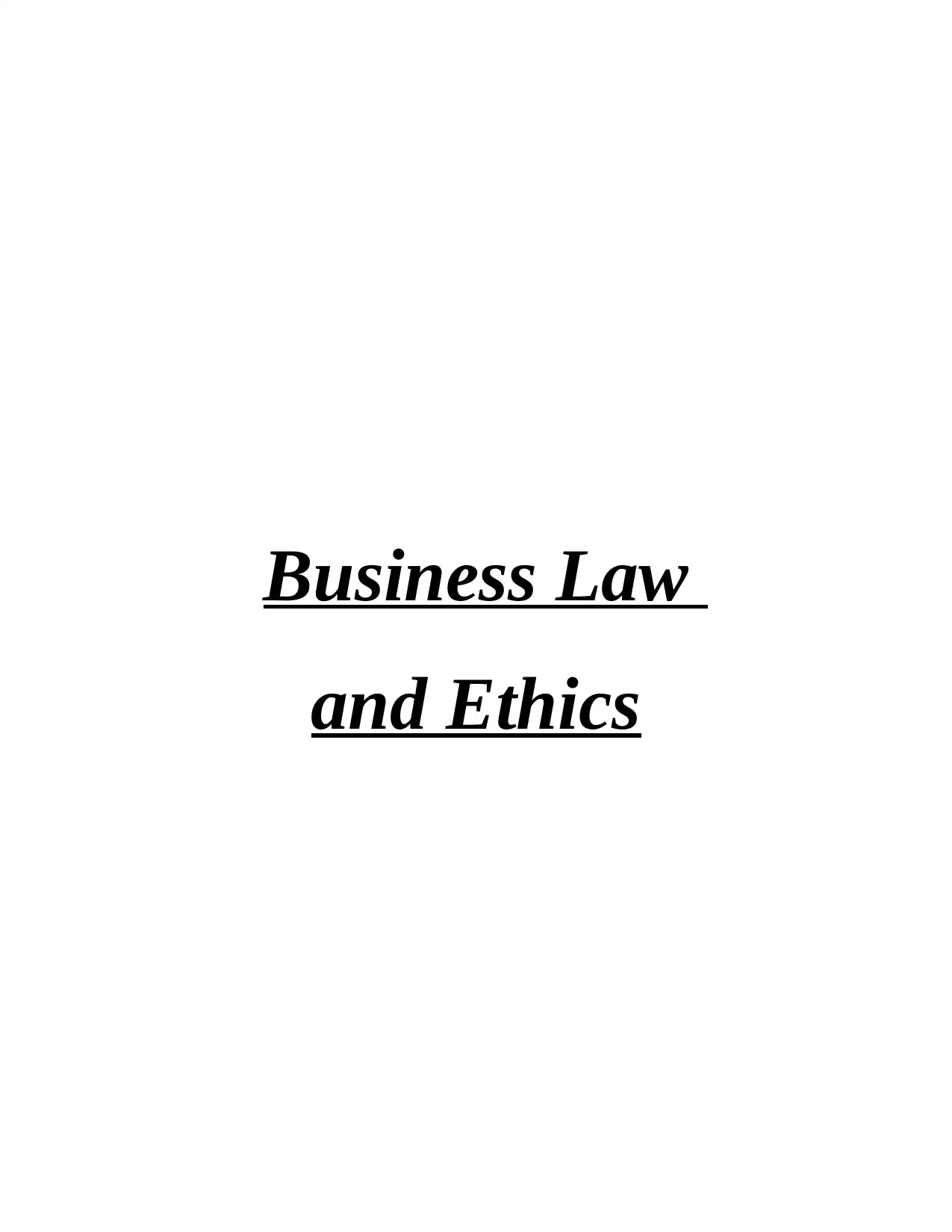
Business Law
and Ethics
and Ethics
Secure Best Marks with AI Grader
Need help grading? Try our AI Grader for instant feedback on your assignments.
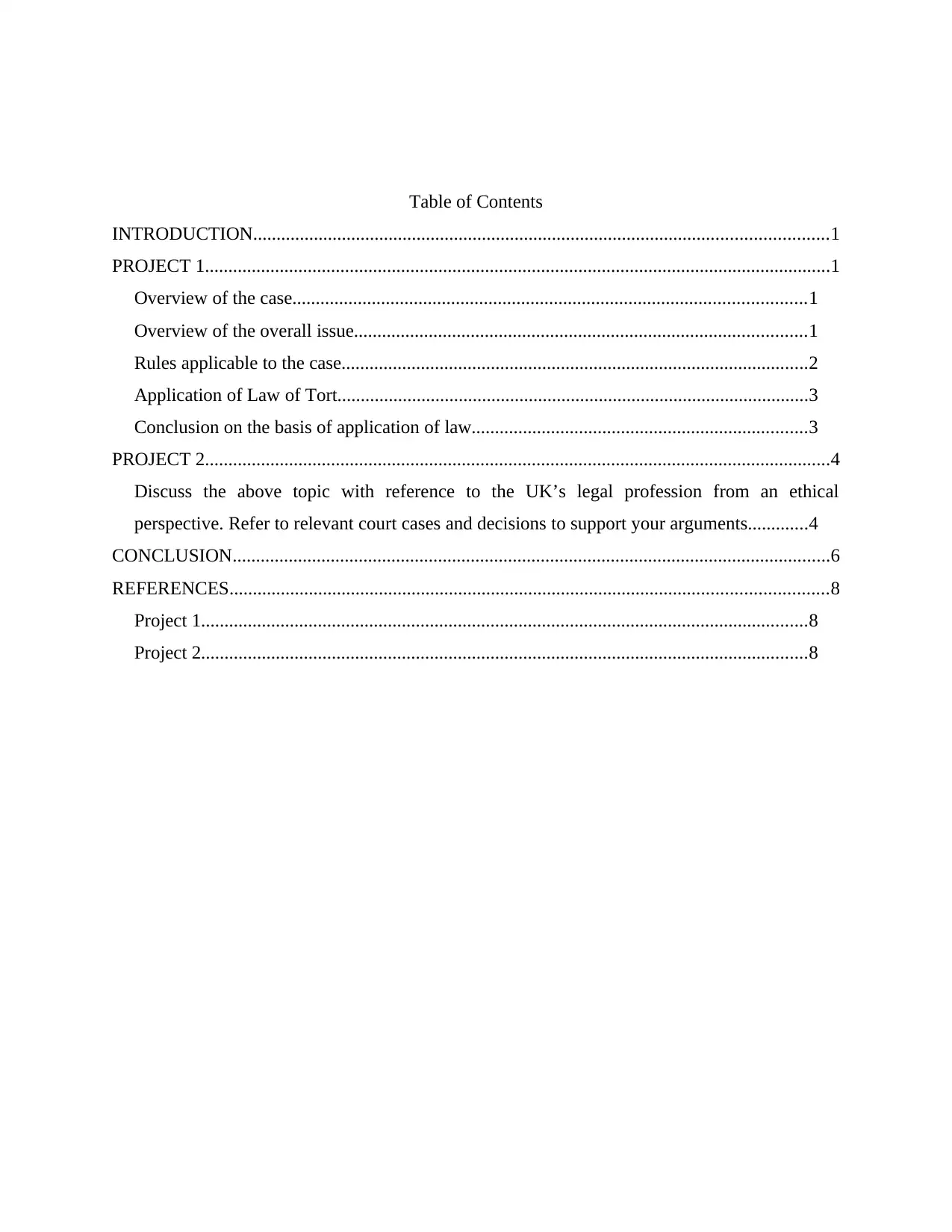
Table of Contents
INTRODUCTION...........................................................................................................................1
PROJECT 1......................................................................................................................................1
Overview of the case..............................................................................................................1
Overview of the overall issue.................................................................................................1
Rules applicable to the case....................................................................................................2
Application of Law of Tort.....................................................................................................3
Conclusion on the basis of application of law........................................................................3
PROJECT 2......................................................................................................................................4
Discuss the above topic with reference to the UK’s legal profession from an ethical
perspective. Refer to relevant court cases and decisions to support your arguments.............4
CONCLUSION................................................................................................................................6
REFERENCES................................................................................................................................8
Project 1..................................................................................................................................8
Project 2..................................................................................................................................8
INTRODUCTION...........................................................................................................................1
PROJECT 1......................................................................................................................................1
Overview of the case..............................................................................................................1
Overview of the overall issue.................................................................................................1
Rules applicable to the case....................................................................................................2
Application of Law of Tort.....................................................................................................3
Conclusion on the basis of application of law........................................................................3
PROJECT 2......................................................................................................................................4
Discuss the above topic with reference to the UK’s legal profession from an ethical
perspective. Refer to relevant court cases and decisions to support your arguments.............4
CONCLUSION................................................................................................................................6
REFERENCES................................................................................................................................8
Project 1..................................................................................................................................8
Project 2..................................................................................................................................8
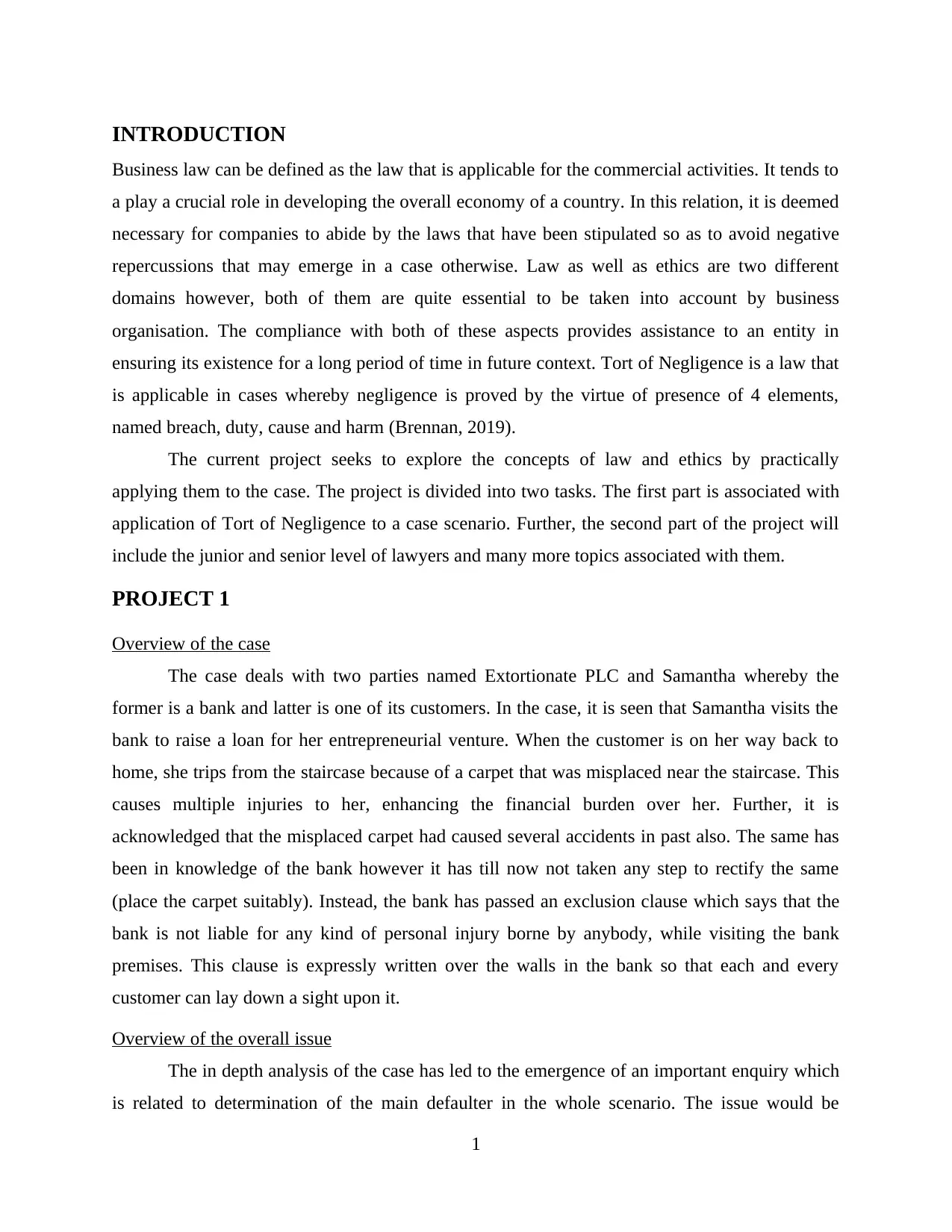
INTRODUCTION
Business law can be defined as the law that is applicable for the commercial activities. It tends to
a play a crucial role in developing the overall economy of a country. In this relation, it is deemed
necessary for companies to abide by the laws that have been stipulated so as to avoid negative
repercussions that may emerge in a case otherwise. Law as well as ethics are two different
domains however, both of them are quite essential to be taken into account by business
organisation. The compliance with both of these aspects provides assistance to an entity in
ensuring its existence for a long period of time in future context. Tort of Negligence is a law that
is applicable in cases whereby negligence is proved by the virtue of presence of 4 elements,
named breach, duty, cause and harm (Brennan, 2019).
The current project seeks to explore the concepts of law and ethics by practically
applying them to the case. The project is divided into two tasks. The first part is associated with
application of Tort of Negligence to a case scenario. Further, the second part of the project will
include the junior and senior level of lawyers and many more topics associated with them.
PROJECT 1
Overview of the case
The case deals with two parties named Extortionate PLC and Samantha whereby the
former is a bank and latter is one of its customers. In the case, it is seen that Samantha visits the
bank to raise a loan for her entrepreneurial venture. When the customer is on her way back to
home, she trips from the staircase because of a carpet that was misplaced near the staircase. This
causes multiple injuries to her, enhancing the financial burden over her. Further, it is
acknowledged that the misplaced carpet had caused several accidents in past also. The same has
been in knowledge of the bank however it has till now not taken any step to rectify the same
(place the carpet suitably). Instead, the bank has passed an exclusion clause which says that the
bank is not liable for any kind of personal injury borne by anybody, while visiting the bank
premises. This clause is expressly written over the walls in the bank so that each and every
customer can lay down a sight upon it.
Overview of the overall issue
The in depth analysis of the case has led to the emergence of an important enquiry which
is related to determination of the main defaulter in the whole scenario. The issue would be
1
Business law can be defined as the law that is applicable for the commercial activities. It tends to
a play a crucial role in developing the overall economy of a country. In this relation, it is deemed
necessary for companies to abide by the laws that have been stipulated so as to avoid negative
repercussions that may emerge in a case otherwise. Law as well as ethics are two different
domains however, both of them are quite essential to be taken into account by business
organisation. The compliance with both of these aspects provides assistance to an entity in
ensuring its existence for a long period of time in future context. Tort of Negligence is a law that
is applicable in cases whereby negligence is proved by the virtue of presence of 4 elements,
named breach, duty, cause and harm (Brennan, 2019).
The current project seeks to explore the concepts of law and ethics by practically
applying them to the case. The project is divided into two tasks. The first part is associated with
application of Tort of Negligence to a case scenario. Further, the second part of the project will
include the junior and senior level of lawyers and many more topics associated with them.
PROJECT 1
Overview of the case
The case deals with two parties named Extortionate PLC and Samantha whereby the
former is a bank and latter is one of its customers. In the case, it is seen that Samantha visits the
bank to raise a loan for her entrepreneurial venture. When the customer is on her way back to
home, she trips from the staircase because of a carpet that was misplaced near the staircase. This
causes multiple injuries to her, enhancing the financial burden over her. Further, it is
acknowledged that the misplaced carpet had caused several accidents in past also. The same has
been in knowledge of the bank however it has till now not taken any step to rectify the same
(place the carpet suitably). Instead, the bank has passed an exclusion clause which says that the
bank is not liable for any kind of personal injury borne by anybody, while visiting the bank
premises. This clause is expressly written over the walls in the bank so that each and every
customer can lay down a sight upon it.
Overview of the overall issue
The in depth analysis of the case has led to the emergence of an important enquiry which
is related to determination of the main defaulter in the whole scenario. The issue would be
1
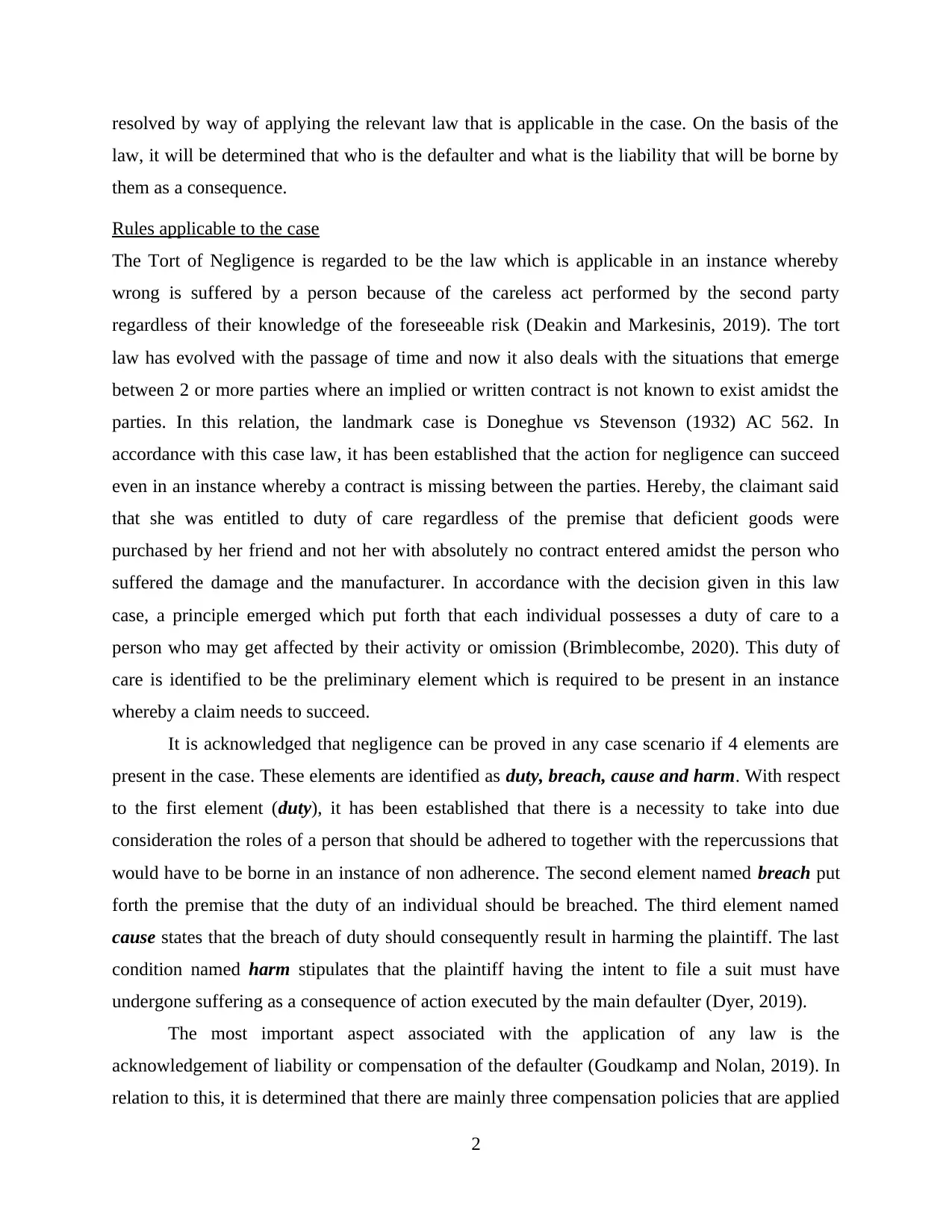
resolved by way of applying the relevant law that is applicable in the case. On the basis of the
law, it will be determined that who is the defaulter and what is the liability that will be borne by
them as a consequence.
Rules applicable to the case
The Tort of Negligence is regarded to be the law which is applicable in an instance whereby
wrong is suffered by a person because of the careless act performed by the second party
regardless of their knowledge of the foreseeable risk (Deakin and Markesinis, 2019). The tort
law has evolved with the passage of time and now it also deals with the situations that emerge
between 2 or more parties where an implied or written contract is not known to exist amidst the
parties. In this relation, the landmark case is Doneghue vs Stevenson (1932) AC 562. In
accordance with this case law, it has been established that the action for negligence can succeed
even in an instance whereby a contract is missing between the parties. Hereby, the claimant said
that she was entitled to duty of care regardless of the premise that deficient goods were
purchased by her friend and not her with absolutely no contract entered amidst the person who
suffered the damage and the manufacturer. In accordance with the decision given in this law
case, a principle emerged which put forth that each individual possesses a duty of care to a
person who may get affected by their activity or omission (Brimblecombe, 2020). This duty of
care is identified to be the preliminary element which is required to be present in an instance
whereby a claim needs to succeed.
It is acknowledged that negligence can be proved in any case scenario if 4 elements are
present in the case. These elements are identified as duty, breach, cause and harm. With respect
to the first element (duty), it has been established that there is a necessity to take into due
consideration the roles of a person that should be adhered to together with the repercussions that
would have to be borne in an instance of non adherence. The second element named breach put
forth the premise that the duty of an individual should be breached. The third element named
cause states that the breach of duty should consequently result in harming the plaintiff. The last
condition named harm stipulates that the plaintiff having the intent to file a suit must have
undergone suffering as a consequence of action executed by the main defaulter (Dyer, 2019).
The most important aspect associated with the application of any law is the
acknowledgement of liability or compensation of the defaulter (Goudkamp and Nolan, 2019). In
relation to this, it is determined that there are mainly three compensation policies that are applied
2
law, it will be determined that who is the defaulter and what is the liability that will be borne by
them as a consequence.
Rules applicable to the case
The Tort of Negligence is regarded to be the law which is applicable in an instance whereby
wrong is suffered by a person because of the careless act performed by the second party
regardless of their knowledge of the foreseeable risk (Deakin and Markesinis, 2019). The tort
law has evolved with the passage of time and now it also deals with the situations that emerge
between 2 or more parties where an implied or written contract is not known to exist amidst the
parties. In this relation, the landmark case is Doneghue vs Stevenson (1932) AC 562. In
accordance with this case law, it has been established that the action for negligence can succeed
even in an instance whereby a contract is missing between the parties. Hereby, the claimant said
that she was entitled to duty of care regardless of the premise that deficient goods were
purchased by her friend and not her with absolutely no contract entered amidst the person who
suffered the damage and the manufacturer. In accordance with the decision given in this law
case, a principle emerged which put forth that each individual possesses a duty of care to a
person who may get affected by their activity or omission (Brimblecombe, 2020). This duty of
care is identified to be the preliminary element which is required to be present in an instance
whereby a claim needs to succeed.
It is acknowledged that negligence can be proved in any case scenario if 4 elements are
present in the case. These elements are identified as duty, breach, cause and harm. With respect
to the first element (duty), it has been established that there is a necessity to take into due
consideration the roles of a person that should be adhered to together with the repercussions that
would have to be borne in an instance of non adherence. The second element named breach put
forth the premise that the duty of an individual should be breached. The third element named
cause states that the breach of duty should consequently result in harming the plaintiff. The last
condition named harm stipulates that the plaintiff having the intent to file a suit must have
undergone suffering as a consequence of action executed by the main defaulter (Dyer, 2019).
The most important aspect associated with the application of any law is the
acknowledgement of liability or compensation of the defaulter (Goudkamp and Nolan, 2019). In
relation to this, it is determined that there are mainly three compensation policies that are applied
2
Secure Best Marks with AI Grader
Need help grading? Try our AI Grader for instant feedback on your assignments.
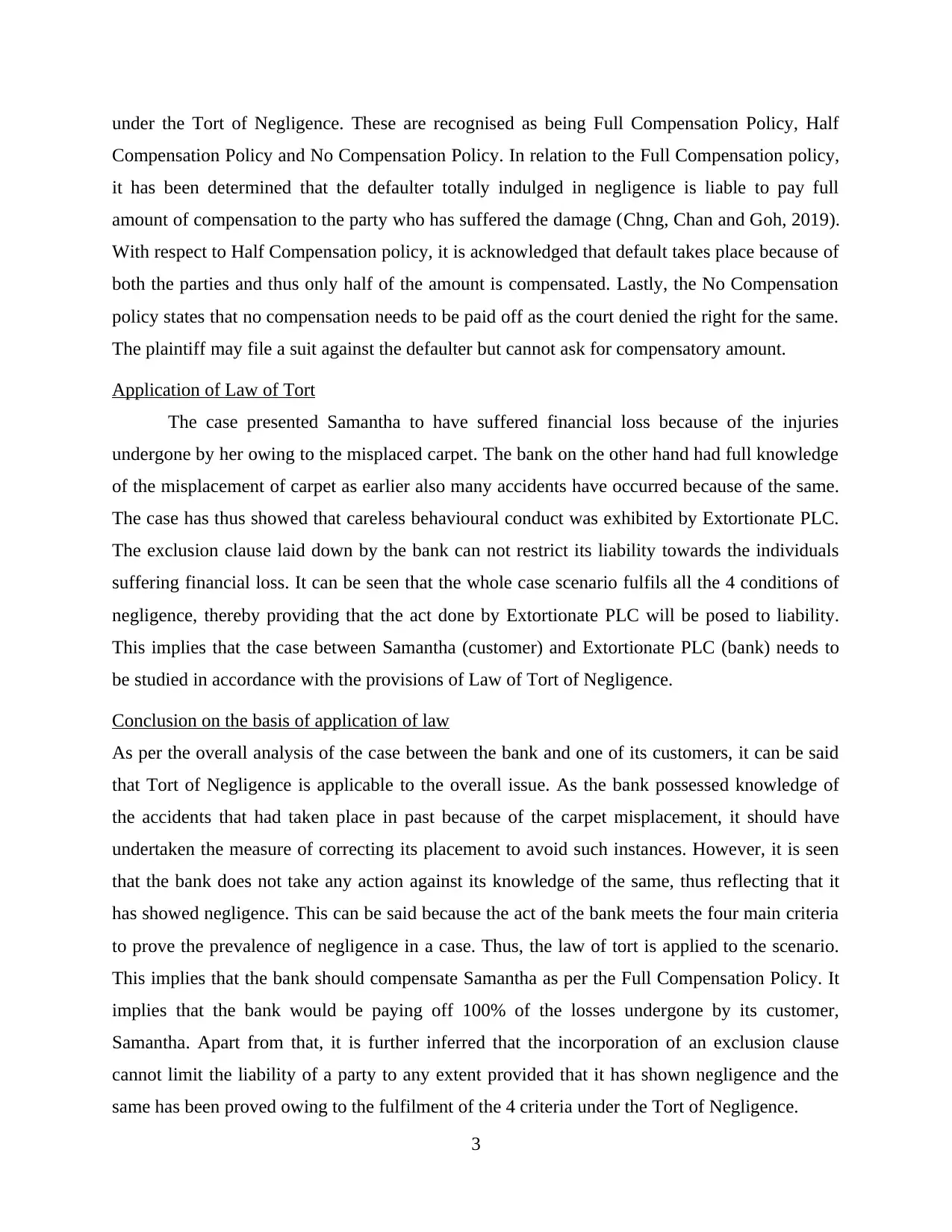
under the Tort of Negligence. These are recognised as being Full Compensation Policy, Half
Compensation Policy and No Compensation Policy. In relation to the Full Compensation policy,
it has been determined that the defaulter totally indulged in negligence is liable to pay full
amount of compensation to the party who has suffered the damage (Chng, Chan and Goh, 2019).
With respect to Half Compensation policy, it is acknowledged that default takes place because of
both the parties and thus only half of the amount is compensated. Lastly, the No Compensation
policy states that no compensation needs to be paid off as the court denied the right for the same.
The plaintiff may file a suit against the defaulter but cannot ask for compensatory amount.
Application of Law of Tort
The case presented Samantha to have suffered financial loss because of the injuries
undergone by her owing to the misplaced carpet. The bank on the other hand had full knowledge
of the misplacement of carpet as earlier also many accidents have occurred because of the same.
The case has thus showed that careless behavioural conduct was exhibited by Extortionate PLC.
The exclusion clause laid down by the bank can not restrict its liability towards the individuals
suffering financial loss. It can be seen that the whole case scenario fulfils all the 4 conditions of
negligence, thereby providing that the act done by Extortionate PLC will be posed to liability.
This implies that the case between Samantha (customer) and Extortionate PLC (bank) needs to
be studied in accordance with the provisions of Law of Tort of Negligence.
Conclusion on the basis of application of law
As per the overall analysis of the case between the bank and one of its customers, it can be said
that Tort of Negligence is applicable to the overall issue. As the bank possessed knowledge of
the accidents that had taken place in past because of the carpet misplacement, it should have
undertaken the measure of correcting its placement to avoid such instances. However, it is seen
that the bank does not take any action against its knowledge of the same, thus reflecting that it
has showed negligence. This can be said because the act of the bank meets the four main criteria
to prove the prevalence of negligence in a case. Thus, the law of tort is applied to the scenario.
This implies that the bank should compensate Samantha as per the Full Compensation Policy. It
implies that the bank would be paying off 100% of the losses undergone by its customer,
Samantha. Apart from that, it is further inferred that the incorporation of an exclusion clause
cannot limit the liability of a party to any extent provided that it has shown negligence and the
same has been proved owing to the fulfilment of the 4 criteria under the Tort of Negligence.
3
Compensation Policy and No Compensation Policy. In relation to the Full Compensation policy,
it has been determined that the defaulter totally indulged in negligence is liable to pay full
amount of compensation to the party who has suffered the damage (Chng, Chan and Goh, 2019).
With respect to Half Compensation policy, it is acknowledged that default takes place because of
both the parties and thus only half of the amount is compensated. Lastly, the No Compensation
policy states that no compensation needs to be paid off as the court denied the right for the same.
The plaintiff may file a suit against the defaulter but cannot ask for compensatory amount.
Application of Law of Tort
The case presented Samantha to have suffered financial loss because of the injuries
undergone by her owing to the misplaced carpet. The bank on the other hand had full knowledge
of the misplacement of carpet as earlier also many accidents have occurred because of the same.
The case has thus showed that careless behavioural conduct was exhibited by Extortionate PLC.
The exclusion clause laid down by the bank can not restrict its liability towards the individuals
suffering financial loss. It can be seen that the whole case scenario fulfils all the 4 conditions of
negligence, thereby providing that the act done by Extortionate PLC will be posed to liability.
This implies that the case between Samantha (customer) and Extortionate PLC (bank) needs to
be studied in accordance with the provisions of Law of Tort of Negligence.
Conclusion on the basis of application of law
As per the overall analysis of the case between the bank and one of its customers, it can be said
that Tort of Negligence is applicable to the overall issue. As the bank possessed knowledge of
the accidents that had taken place in past because of the carpet misplacement, it should have
undertaken the measure of correcting its placement to avoid such instances. However, it is seen
that the bank does not take any action against its knowledge of the same, thus reflecting that it
has showed negligence. This can be said because the act of the bank meets the four main criteria
to prove the prevalence of negligence in a case. Thus, the law of tort is applied to the scenario.
This implies that the bank should compensate Samantha as per the Full Compensation Policy. It
implies that the bank would be paying off 100% of the losses undergone by its customer,
Samantha. Apart from that, it is further inferred that the incorporation of an exclusion clause
cannot limit the liability of a party to any extent provided that it has shown negligence and the
same has been proved owing to the fulfilment of the 4 criteria under the Tort of Negligence.
3
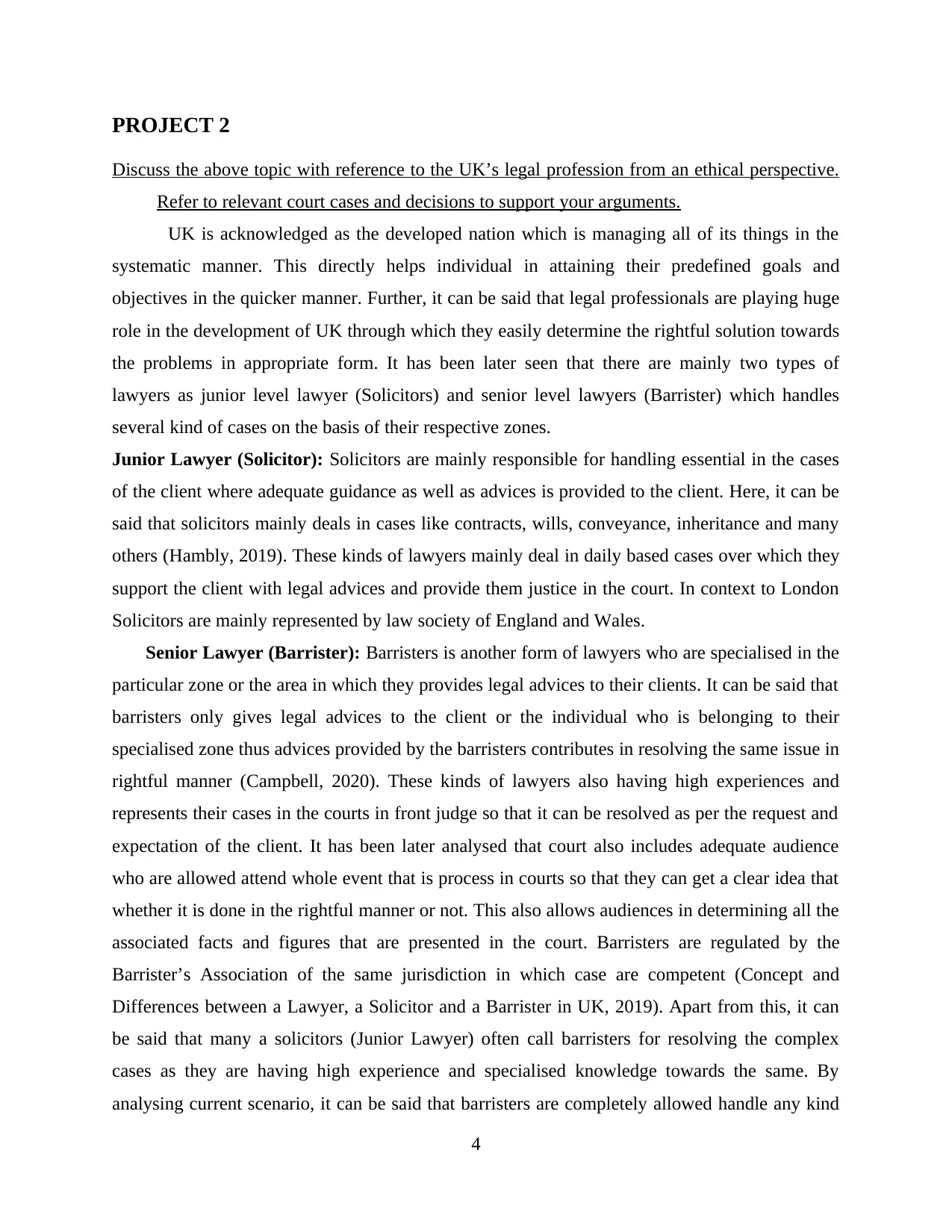
PROJECT 2
Discuss the above topic with reference to the UK’s legal profession from an ethical perspective.
Refer to relevant court cases and decisions to support your arguments.
UK is acknowledged as the developed nation which is managing all of its things in the
systematic manner. This directly helps individual in attaining their predefined goals and
objectives in the quicker manner. Further, it can be said that legal professionals are playing huge
role in the development of UK through which they easily determine the rightful solution towards
the problems in appropriate form. It has been later seen that there are mainly two types of
lawyers as junior level lawyer (Solicitors) and senior level lawyers (Barrister) which handles
several kind of cases on the basis of their respective zones.
Junior Lawyer (Solicitor): Solicitors are mainly responsible for handling essential in the cases
of the client where adequate guidance as well as advices is provided to the client. Here, it can be
said that solicitors mainly deals in cases like contracts, wills, conveyance, inheritance and many
others (Hambly, 2019). These kinds of lawyers mainly deal in daily based cases over which they
support the client with legal advices and provide them justice in the court. In context to London
Solicitors are mainly represented by law society of England and Wales.
Senior Lawyer (Barrister): Barristers is another form of lawyers who are specialised in the
particular zone or the area in which they provides legal advices to their clients. It can be said that
barristers only gives legal advices to the client or the individual who is belonging to their
specialised zone thus advices provided by the barristers contributes in resolving the same issue in
rightful manner (Campbell, 2020). These kinds of lawyers also having high experiences and
represents their cases in the courts in front judge so that it can be resolved as per the request and
expectation of the client. It has been later analysed that court also includes adequate audience
who are allowed attend whole event that is process in courts so that they can get a clear idea that
whether it is done in the rightful manner or not. This also allows audiences in determining all the
associated facts and figures that are presented in the court. Barristers are regulated by the
Barrister’s Association of the same jurisdiction in which case are competent (Concept and
Differences between a Lawyer, a Solicitor and a Barrister in UK, 2019). Apart from this, it can
be said that many a solicitors (Junior Lawyer) often call barristers for resolving the complex
cases as they are having high experience and specialised knowledge towards the same. By
analysing current scenario, it can be said that barristers are completely allowed handle any kind
4
Discuss the above topic with reference to the UK’s legal profession from an ethical perspective.
Refer to relevant court cases and decisions to support your arguments.
UK is acknowledged as the developed nation which is managing all of its things in the
systematic manner. This directly helps individual in attaining their predefined goals and
objectives in the quicker manner. Further, it can be said that legal professionals are playing huge
role in the development of UK through which they easily determine the rightful solution towards
the problems in appropriate form. It has been later seen that there are mainly two types of
lawyers as junior level lawyer (Solicitors) and senior level lawyers (Barrister) which handles
several kind of cases on the basis of their respective zones.
Junior Lawyer (Solicitor): Solicitors are mainly responsible for handling essential in the cases
of the client where adequate guidance as well as advices is provided to the client. Here, it can be
said that solicitors mainly deals in cases like contracts, wills, conveyance, inheritance and many
others (Hambly, 2019). These kinds of lawyers mainly deal in daily based cases over which they
support the client with legal advices and provide them justice in the court. In context to London
Solicitors are mainly represented by law society of England and Wales.
Senior Lawyer (Barrister): Barristers is another form of lawyers who are specialised in the
particular zone or the area in which they provides legal advices to their clients. It can be said that
barristers only gives legal advices to the client or the individual who is belonging to their
specialised zone thus advices provided by the barristers contributes in resolving the same issue in
rightful manner (Campbell, 2020). These kinds of lawyers also having high experiences and
represents their cases in the courts in front judge so that it can be resolved as per the request and
expectation of the client. It has been later analysed that court also includes adequate audience
who are allowed attend whole event that is process in courts so that they can get a clear idea that
whether it is done in the rightful manner or not. This also allows audiences in determining all the
associated facts and figures that are presented in the court. Barristers are regulated by the
Barrister’s Association of the same jurisdiction in which case are competent (Concept and
Differences between a Lawyer, a Solicitor and a Barrister in UK, 2019). Apart from this, it can
be said that many a solicitors (Junior Lawyer) often call barristers for resolving the complex
cases as they are having high experience and specialised knowledge towards the same. By
analysing current scenario, it can be said that barristers are completely allowed handle any kind
4
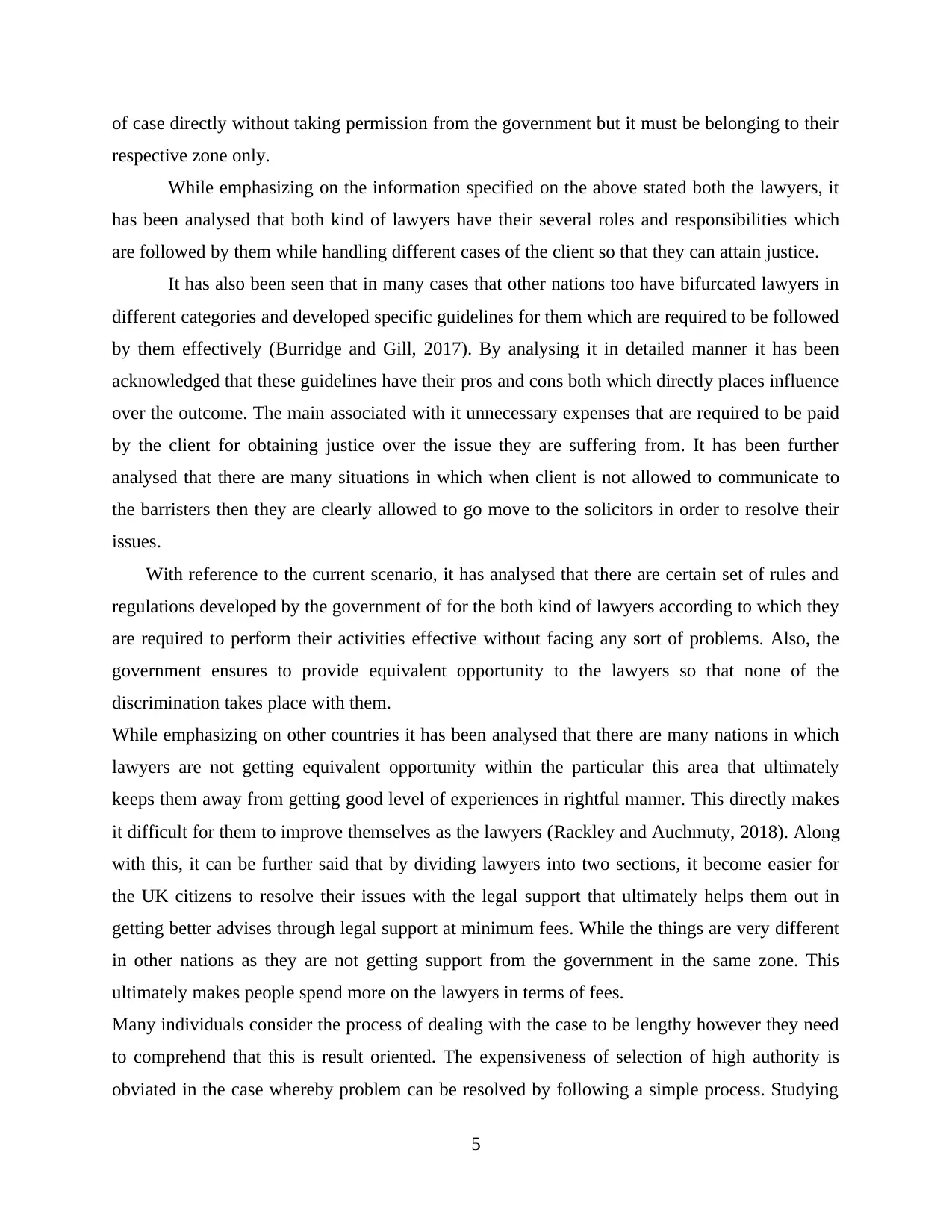
of case directly without taking permission from the government but it must be belonging to their
respective zone only.
While emphasizing on the information specified on the above stated both the lawyers, it
has been analysed that both kind of lawyers have their several roles and responsibilities which
are followed by them while handling different cases of the client so that they can attain justice.
It has also been seen that in many cases that other nations too have bifurcated lawyers in
different categories and developed specific guidelines for them which are required to be followed
by them effectively (Burridge and Gill, 2017). By analysing it in detailed manner it has been
acknowledged that these guidelines have their pros and cons both which directly places influence
over the outcome. The main associated with it unnecessary expenses that are required to be paid
by the client for obtaining justice over the issue they are suffering from. It has been further
analysed that there are many situations in which when client is not allowed to communicate to
the barristers then they are clearly allowed to go move to the solicitors in order to resolve their
issues.
With reference to the current scenario, it has analysed that there are certain set of rules and
regulations developed by the government of for the both kind of lawyers according to which they
are required to perform their activities effective without facing any sort of problems. Also, the
government ensures to provide equivalent opportunity to the lawyers so that none of the
discrimination takes place with them.
While emphasizing on other countries it has been analysed that there are many nations in which
lawyers are not getting equivalent opportunity within the particular this area that ultimately
keeps them away from getting good level of experiences in rightful manner. This directly makes
it difficult for them to improve themselves as the lawyers (Rackley and Auchmuty, 2018). Along
with this, it can be further said that by dividing lawyers into two sections, it become easier for
the UK citizens to resolve their issues with the legal support that ultimately helps them out in
getting better advises through legal support at minimum fees. While the things are very different
in other nations as they are not getting support from the government in the same zone. This
ultimately makes people spend more on the lawyers in terms of fees.
Many individuals consider the process of dealing with the case to be lengthy however they need
to comprehend that this is result oriented. The expensiveness of selection of high authority is
obviated in the case whereby problem can be resolved by following a simple process. Studying
5
respective zone only.
While emphasizing on the information specified on the above stated both the lawyers, it
has been analysed that both kind of lawyers have their several roles and responsibilities which
are followed by them while handling different cases of the client so that they can attain justice.
It has also been seen that in many cases that other nations too have bifurcated lawyers in
different categories and developed specific guidelines for them which are required to be followed
by them effectively (Burridge and Gill, 2017). By analysing it in detailed manner it has been
acknowledged that these guidelines have their pros and cons both which directly places influence
over the outcome. The main associated with it unnecessary expenses that are required to be paid
by the client for obtaining justice over the issue they are suffering from. It has been further
analysed that there are many situations in which when client is not allowed to communicate to
the barristers then they are clearly allowed to go move to the solicitors in order to resolve their
issues.
With reference to the current scenario, it has analysed that there are certain set of rules and
regulations developed by the government of for the both kind of lawyers according to which they
are required to perform their activities effective without facing any sort of problems. Also, the
government ensures to provide equivalent opportunity to the lawyers so that none of the
discrimination takes place with them.
While emphasizing on other countries it has been analysed that there are many nations in which
lawyers are not getting equivalent opportunity within the particular this area that ultimately
keeps them away from getting good level of experiences in rightful manner. This directly makes
it difficult for them to improve themselves as the lawyers (Rackley and Auchmuty, 2018). Along
with this, it can be further said that by dividing lawyers into two sections, it become easier for
the UK citizens to resolve their issues with the legal support that ultimately helps them out in
getting better advises through legal support at minimum fees. While the things are very different
in other nations as they are not getting support from the government in the same zone. This
ultimately makes people spend more on the lawyers in terms of fees.
Many individuals consider the process of dealing with the case to be lengthy however they need
to comprehend that this is result oriented. The expensiveness of selection of high authority is
obviated in the case whereby problem can be resolved by following a simple process. Studying
5
Paraphrase This Document
Need a fresh take? Get an instant paraphrase of this document with our AI Paraphraser
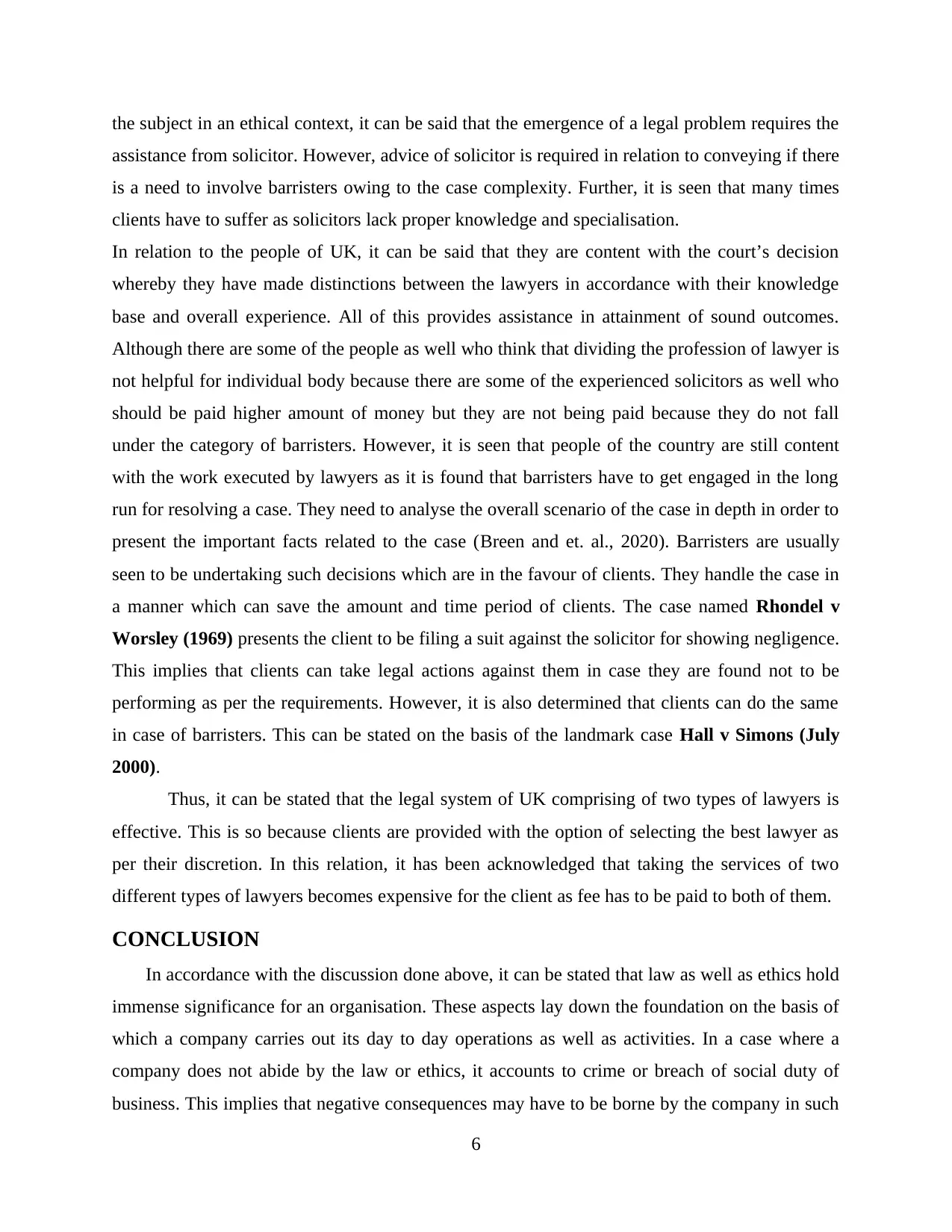
the subject in an ethical context, it can be said that the emergence of a legal problem requires the
assistance from solicitor. However, advice of solicitor is required in relation to conveying if there
is a need to involve barristers owing to the case complexity. Further, it is seen that many times
clients have to suffer as solicitors lack proper knowledge and specialisation.
In relation to the people of UK, it can be said that they are content with the court’s decision
whereby they have made distinctions between the lawyers in accordance with their knowledge
base and overall experience. All of this provides assistance in attainment of sound outcomes.
Although there are some of the people as well who think that dividing the profession of lawyer is
not helpful for individual body because there are some of the experienced solicitors as well who
should be paid higher amount of money but they are not being paid because they do not fall
under the category of barristers. However, it is seen that people of the country are still content
with the work executed by lawyers as it is found that barristers have to get engaged in the long
run for resolving a case. They need to analyse the overall scenario of the case in depth in order to
present the important facts related to the case (Breen and et. al., 2020). Barristers are usually
seen to be undertaking such decisions which are in the favour of clients. They handle the case in
a manner which can save the amount and time period of clients. The case named Rhondel v
Worsley (1969) presents the client to be filing a suit against the solicitor for showing negligence.
This implies that clients can take legal actions against them in case they are found not to be
performing as per the requirements. However, it is also determined that clients can do the same
in case of barristers. This can be stated on the basis of the landmark case Hall v Simons (July
2000).
Thus, it can be stated that the legal system of UK comprising of two types of lawyers is
effective. This is so because clients are provided with the option of selecting the best lawyer as
per their discretion. In this relation, it has been acknowledged that taking the services of two
different types of lawyers becomes expensive for the client as fee has to be paid to both of them.
CONCLUSION
In accordance with the discussion done above, it can be stated that law as well as ethics hold
immense significance for an organisation. These aspects lay down the foundation on the basis of
which a company carries out its day to day operations as well as activities. In a case where a
company does not abide by the law or ethics, it accounts to crime or breach of social duty of
business. This implies that negative consequences may have to be borne by the company in such
6
assistance from solicitor. However, advice of solicitor is required in relation to conveying if there
is a need to involve barristers owing to the case complexity. Further, it is seen that many times
clients have to suffer as solicitors lack proper knowledge and specialisation.
In relation to the people of UK, it can be said that they are content with the court’s decision
whereby they have made distinctions between the lawyers in accordance with their knowledge
base and overall experience. All of this provides assistance in attainment of sound outcomes.
Although there are some of the people as well who think that dividing the profession of lawyer is
not helpful for individual body because there are some of the experienced solicitors as well who
should be paid higher amount of money but they are not being paid because they do not fall
under the category of barristers. However, it is seen that people of the country are still content
with the work executed by lawyers as it is found that barristers have to get engaged in the long
run for resolving a case. They need to analyse the overall scenario of the case in depth in order to
present the important facts related to the case (Breen and et. al., 2020). Barristers are usually
seen to be undertaking such decisions which are in the favour of clients. They handle the case in
a manner which can save the amount and time period of clients. The case named Rhondel v
Worsley (1969) presents the client to be filing a suit against the solicitor for showing negligence.
This implies that clients can take legal actions against them in case they are found not to be
performing as per the requirements. However, it is also determined that clients can do the same
in case of barristers. This can be stated on the basis of the landmark case Hall v Simons (July
2000).
Thus, it can be stated that the legal system of UK comprising of two types of lawyers is
effective. This is so because clients are provided with the option of selecting the best lawyer as
per their discretion. In this relation, it has been acknowledged that taking the services of two
different types of lawyers becomes expensive for the client as fee has to be paid to both of them.
CONCLUSION
In accordance with the discussion done above, it can be stated that law as well as ethics hold
immense significance for an organisation. These aspects lay down the foundation on the basis of
which a company carries out its day to day operations as well as activities. In a case where a
company does not abide by the law or ethics, it accounts to crime or breach of social duty of
business. This implies that negative consequences may have to be borne by the company in such
6
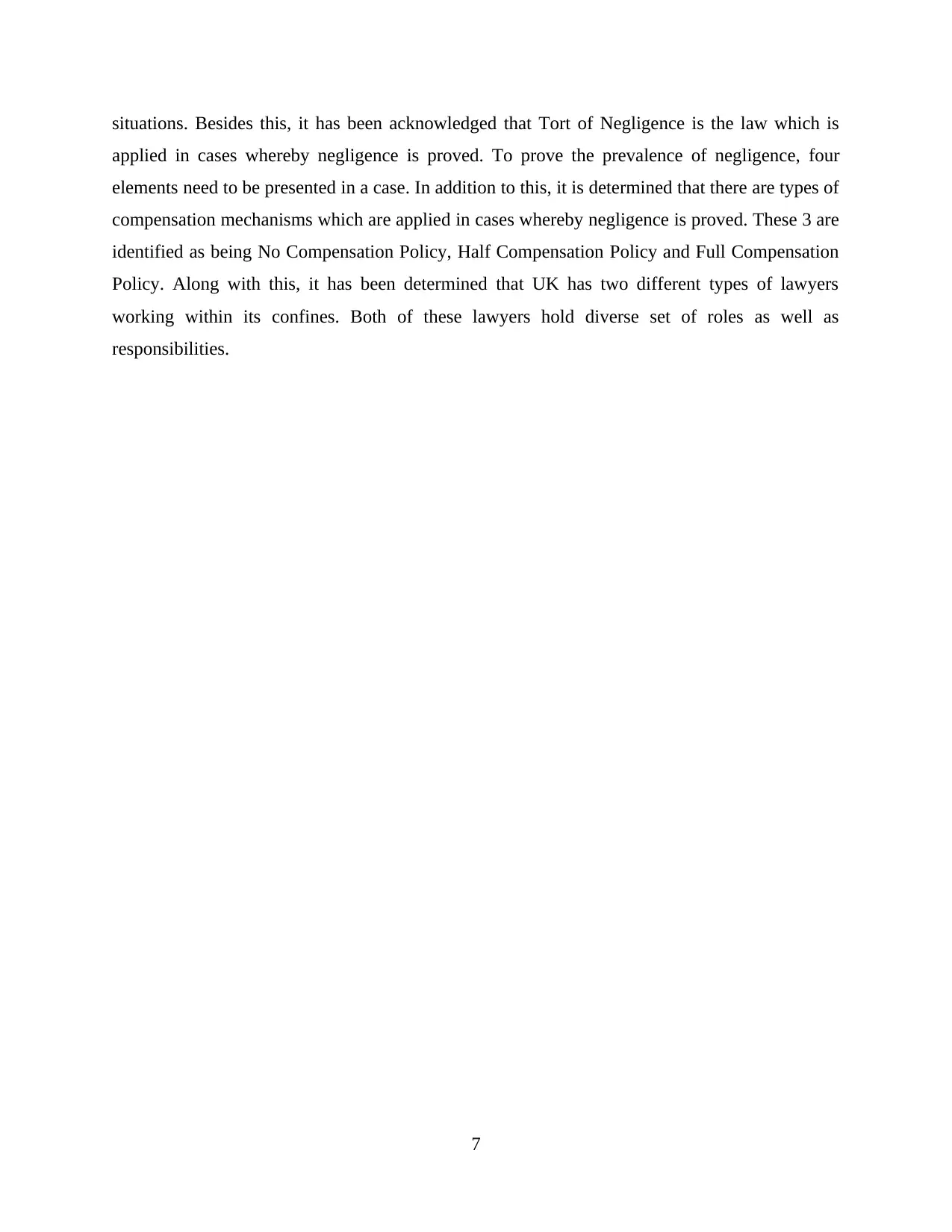
situations. Besides this, it has been acknowledged that Tort of Negligence is the law which is
applied in cases whereby negligence is proved. To prove the prevalence of negligence, four
elements need to be presented in a case. In addition to this, it is determined that there are types of
compensation mechanisms which are applied in cases whereby negligence is proved. These 3 are
identified as being No Compensation Policy, Half Compensation Policy and Full Compensation
Policy. Along with this, it has been determined that UK has two different types of lawyers
working within its confines. Both of these lawyers hold diverse set of roles as well as
responsibilities.
7
applied in cases whereby negligence is proved. To prove the prevalence of negligence, four
elements need to be presented in a case. In addition to this, it is determined that there are types of
compensation mechanisms which are applied in cases whereby negligence is proved. These 3 are
identified as being No Compensation Policy, Half Compensation Policy and Full Compensation
Policy. Along with this, it has been determined that UK has two different types of lawyers
working within its confines. Both of these lawyers hold diverse set of roles as well as
responsibilities.
7
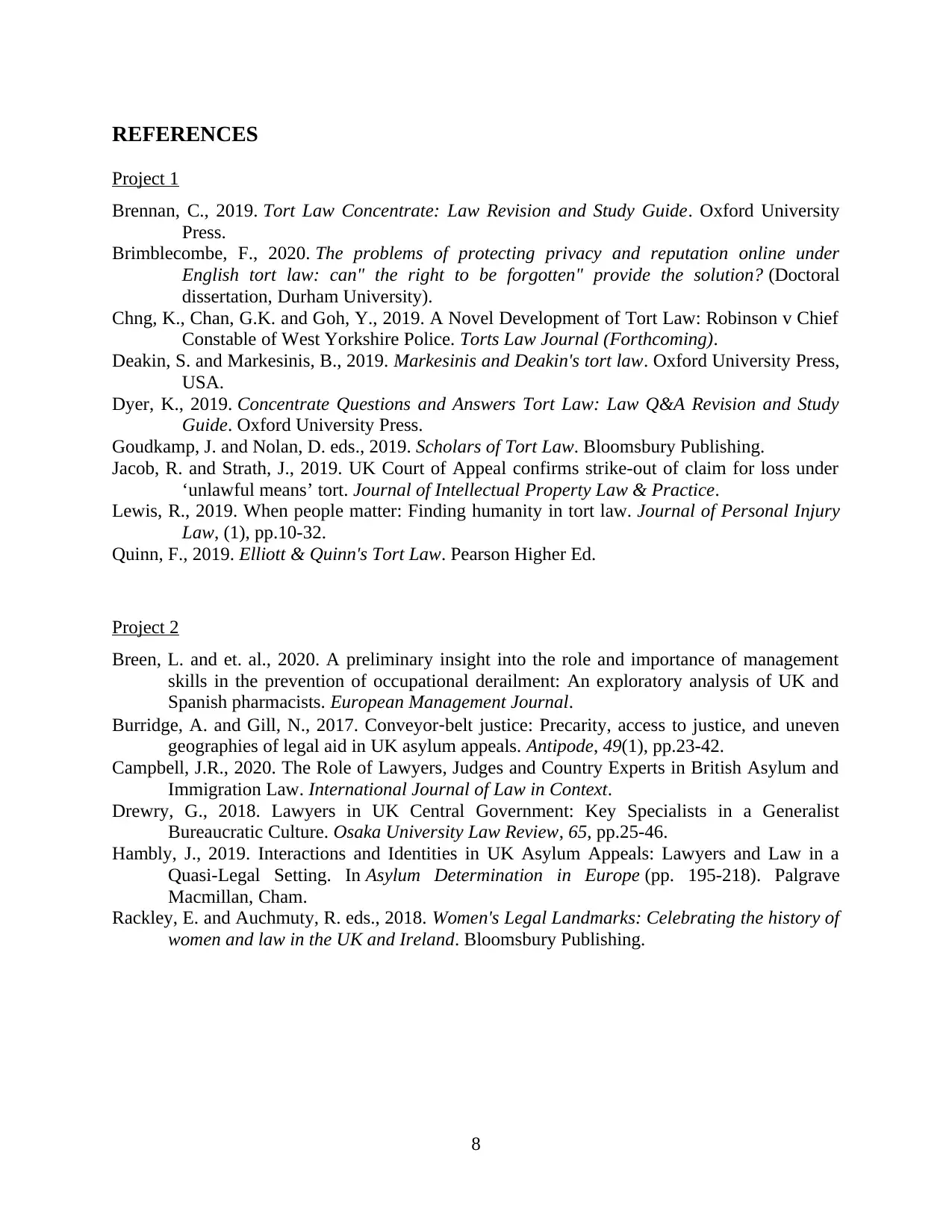
REFERENCES
Project 1
Brennan, C., 2019. Tort Law Concentrate: Law Revision and Study Guide. Oxford University
Press.
Brimblecombe, F., 2020. The problems of protecting privacy and reputation online under
English tort law: can" the right to be forgotten" provide the solution? (Doctoral
dissertation, Durham University).
Chng, K., Chan, G.K. and Goh, Y., 2019. A Novel Development of Tort Law: Robinson v Chief
Constable of West Yorkshire Police. Torts Law Journal (Forthcoming).
Deakin, S. and Markesinis, B., 2019. Markesinis and Deakin's tort law. Oxford University Press,
USA.
Dyer, K., 2019. Concentrate Questions and Answers Tort Law: Law Q&A Revision and Study
Guide. Oxford University Press.
Goudkamp, J. and Nolan, D. eds., 2019. Scholars of Tort Law. Bloomsbury Publishing.
Jacob, R. and Strath, J., 2019. UK Court of Appeal confirms strike-out of claim for loss under
‘unlawful means’ tort. Journal of Intellectual Property Law & Practice.
Lewis, R., 2019. When people matter: Finding humanity in tort law. Journal of Personal Injury
Law, (1), pp.10-32.
Quinn, F., 2019. Elliott & Quinn's Tort Law. Pearson Higher Ed.
Project 2
Breen, L. and et. al., 2020. A preliminary insight into the role and importance of management
skills in the prevention of occupational derailment: An exploratory analysis of UK and
Spanish pharmacists. European Management Journal.
Burridge, A. and Gill, N., 2017. Conveyor‐belt justice: Precarity, access to justice, and uneven
geographies of legal aid in UK asylum appeals. Antipode, 49(1), pp.23-42.
Campbell, J.R., 2020. The Role of Lawyers, Judges and Country Experts in British Asylum and
Immigration Law. International Journal of Law in Context.
Drewry, G., 2018. Lawyers in UK Central Government: Key Specialists in a Generalist
Bureaucratic Culture. Osaka University Law Review, 65, pp.25-46.
Hambly, J., 2019. Interactions and Identities in UK Asylum Appeals: Lawyers and Law in a
Quasi-Legal Setting. In Asylum Determination in Europe (pp. 195-218). Palgrave
Macmillan, Cham.
Rackley, E. and Auchmuty, R. eds., 2018. Women's Legal Landmarks: Celebrating the history of
women and law in the UK and Ireland. Bloomsbury Publishing.
8
Project 1
Brennan, C., 2019. Tort Law Concentrate: Law Revision and Study Guide. Oxford University
Press.
Brimblecombe, F., 2020. The problems of protecting privacy and reputation online under
English tort law: can" the right to be forgotten" provide the solution? (Doctoral
dissertation, Durham University).
Chng, K., Chan, G.K. and Goh, Y., 2019. A Novel Development of Tort Law: Robinson v Chief
Constable of West Yorkshire Police. Torts Law Journal (Forthcoming).
Deakin, S. and Markesinis, B., 2019. Markesinis and Deakin's tort law. Oxford University Press,
USA.
Dyer, K., 2019. Concentrate Questions and Answers Tort Law: Law Q&A Revision and Study
Guide. Oxford University Press.
Goudkamp, J. and Nolan, D. eds., 2019. Scholars of Tort Law. Bloomsbury Publishing.
Jacob, R. and Strath, J., 2019. UK Court of Appeal confirms strike-out of claim for loss under
‘unlawful means’ tort. Journal of Intellectual Property Law & Practice.
Lewis, R., 2019. When people matter: Finding humanity in tort law. Journal of Personal Injury
Law, (1), pp.10-32.
Quinn, F., 2019. Elliott & Quinn's Tort Law. Pearson Higher Ed.
Project 2
Breen, L. and et. al., 2020. A preliminary insight into the role and importance of management
skills in the prevention of occupational derailment: An exploratory analysis of UK and
Spanish pharmacists. European Management Journal.
Burridge, A. and Gill, N., 2017. Conveyor‐belt justice: Precarity, access to justice, and uneven
geographies of legal aid in UK asylum appeals. Antipode, 49(1), pp.23-42.
Campbell, J.R., 2020. The Role of Lawyers, Judges and Country Experts in British Asylum and
Immigration Law. International Journal of Law in Context.
Drewry, G., 2018. Lawyers in UK Central Government: Key Specialists in a Generalist
Bureaucratic Culture. Osaka University Law Review, 65, pp.25-46.
Hambly, J., 2019. Interactions and Identities in UK Asylum Appeals: Lawyers and Law in a
Quasi-Legal Setting. In Asylum Determination in Europe (pp. 195-218). Palgrave
Macmillan, Cham.
Rackley, E. and Auchmuty, R. eds., 2018. Women's Legal Landmarks: Celebrating the history of
women and law in the UK and Ireland. Bloomsbury Publishing.
8
1 out of 10
Related Documents
Your All-in-One AI-Powered Toolkit for Academic Success.
+13062052269
info@desklib.com
Available 24*7 on WhatsApp / Email
![[object Object]](/_next/static/media/star-bottom.7253800d.svg)
Unlock your academic potential
© 2024 | Zucol Services PVT LTD | All rights reserved.





